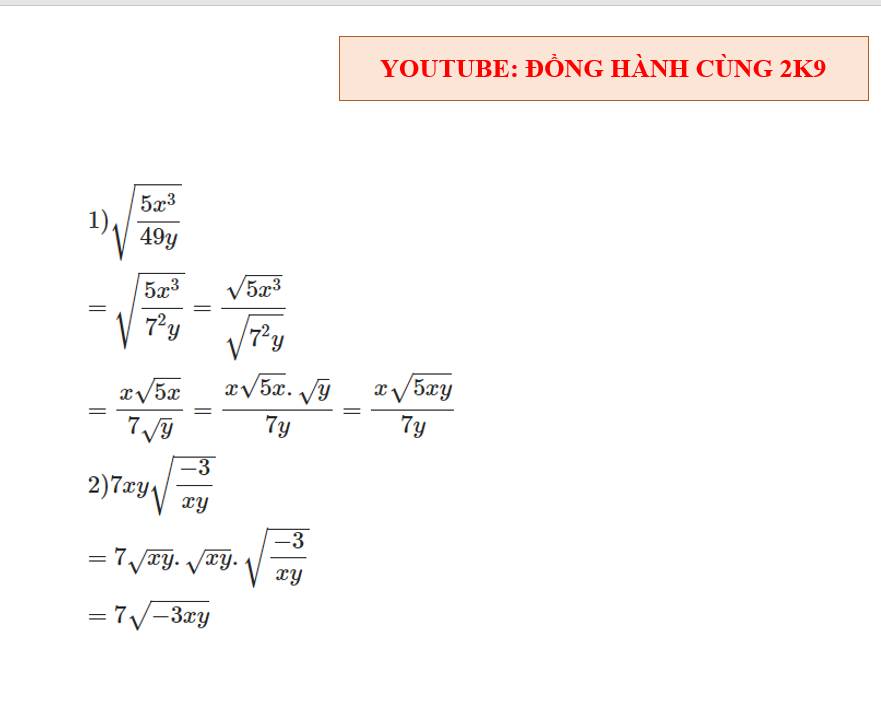Khử mẫu của biểu thức dưới dấu căn bậc hai
a) \(\sqrt{\dfrac{5x^3}{49y}}\)
với x ≥ 0, y >0
b) 7xy\(\sqrt{\dfrac{-3}{xy}}\)
với x<0, y>0
Hãy nhập câu hỏi của bạn vào đây, nếu là tài khoản VIP, bạn sẽ được ưu tiên trả lời.



f: \(\dfrac{2}{\sqrt{6}-\sqrt{5}}=2\sqrt{6}+2\sqrt{5}\)
l: \(\dfrac{3}{\sqrt{10}+\sqrt{7}}=\sqrt{10}-\sqrt{7}\)

a, \(A=\left(\dfrac{2\sqrt{x}}{\sqrt{x}+3}+\dfrac{\sqrt{x}}{\sqrt{x}-3}-\dfrac{3x+3}{x-9}\right):\left(\dfrac{2\sqrt{x}-2}{\sqrt{x}-3}-1\right)\)
\(=\left[\dfrac{2\sqrt{x}\left(\sqrt{x}-3\right)}{\left(\sqrt{x}+3\right)\left(\sqrt{x}-3\right)}+\dfrac{\sqrt{x}\left(\sqrt{x}+3\right)}{\left(\sqrt{x}+3\right)\left(\sqrt{x}-3\right)}-\dfrac{3x+3}{\left(\sqrt{x}+3\right)\left(\sqrt{x}-3\right)}\right]:\dfrac{2\sqrt{x}-2-\sqrt{x}+3}{\sqrt{x}-3}\)
\(=\dfrac{2x-6\sqrt{x}+x+3\sqrt{x}-3x-3}{\left(\sqrt{x}+3\right)\left(\sqrt{x}-3\right)}:\dfrac{2\sqrt{x}-2-\sqrt{x}+3}{\sqrt{x}-3}\)
\(=\dfrac{-3\sqrt{x}-3}{\left(\sqrt{x}+3\right)\left(\sqrt{x}-3\right)}:\dfrac{\sqrt{x}-3}{\sqrt{x}+1}\)
\(=\dfrac{-3}{\sqrt{x}+3}\)
b, \(A\in Z\Leftrightarrow\dfrac{-3}{\sqrt{x}+3}\in Z\)
\(\Leftrightarrow\sqrt{x}+3\inƯ_3=\left\{\pm1;\pm3\right\}\)
\(\Leftrightarrow\sqrt{x}=0\)
\(\Leftrightarrow x=0\)
\(a,A=\left(\dfrac{2\sqrt{x}}{\sqrt{x}+3}+\dfrac{\sqrt{x}}{\sqrt{x}-3}-\dfrac{3x+3}{x-9}\right):\left(\dfrac{2\sqrt{x}-2}{\sqrt{x}-3}-1\right)\left(x\ge0;x\ne9\right)\\ A=\dfrac{2\sqrt{x}\left(\sqrt{x}-3\right)+\sqrt{x}\left(\sqrt{x}+3\right)-3x-3}{\left(\sqrt{x}-3\right)\left(\sqrt{x}+3\right)}:\dfrac{2\sqrt{x}-2-\sqrt{x}+3}{\sqrt{x}-3}\\ A=\dfrac{2x-6\sqrt{x}+x+3\sqrt{x}-3x-3}{\left(\sqrt{x}+3\right)\left(\sqrt{x}-3\right)}\cdot\dfrac{\sqrt{x}-3}{\sqrt{x}+1}\\ A=\dfrac{-3\left(\sqrt{x}+1\right)}{\left(\sqrt{x}+3\right)\left(\sqrt{x}-3\right)}\cdot\dfrac{\sqrt{x}-3}{\sqrt{x}+1}=\dfrac{-3}{\sqrt{x}+3}\)
\(b,A\in Z\Leftrightarrow\dfrac{-3}{\sqrt{x}+3}\in Z\Leftrightarrow-3⋮\sqrt{x}+3\\ \Leftrightarrow\sqrt{x}+3\inƯ\left(-3\right)=\left\{-3;-1;1;3\right\}\\ \Leftrightarrow\sqrt{x}\in\left\{-6;-4;-2;0\right\}\)
Mà \(\sqrt{x}\ge0\)
\(\Leftrightarrow x\in\left\{0\right\}\)
Vậy \(x=0\) thì A nguyên

\(\left(\dfrac{1}{\sqrt{x}-1}-\dfrac{1}{\sqrt{x}+1}\right):\dfrac{x+1}{x-1}\\ =\dfrac{\sqrt{x}+1-\sqrt{x}+1}{\left(\sqrt{x}-1\right)\left(\sqrt{x}+1\right)}\cdot\dfrac{x-1}{x+1}=\dfrac{2}{x-1}\cdot\dfrac{x-1}{x+1}\\ =\dfrac{2}{x+1}\)
\(\bigg(\dfrac{1}{\sqrt x-1}-\dfrac{1}{\sqrt x+1}\bigg):\dfrac{x+1}{x-1}\\=\bigg(\dfrac{\sqrt x+1}{(\sqrt x-1)(\sqrt x+1)}-\dfrac{\sqrt x-1}{(\sqrt x-1)(\sqrt x+1)}\bigg.\dfrac{x-1}{x+1}\\=\dfrac{\sqrt x+1-\sqrt x+1}{(\sqrt x-1)(\sqrt x+1)}.\dfrac{(\sqrt x-1)(\sqrt x+1)}{x+1}\\=\dfrac{2}{x+1}\)

a: \(\dfrac{5}{\sqrt{10}}=\dfrac{5\sqrt{10}}{10}=\dfrac{\sqrt{10}}{2}\)
b: \(\dfrac{5}{2\sqrt{5}}=\dfrac{\sqrt{5}}{2}\)
c: \(\dfrac{1}{3\sqrt{20}}=\dfrac{\sqrt{5}}{30}\)
a)\(\dfrac{5}{\sqrt{10}}=\dfrac{5\sqrt{10}}{10}=\dfrac{\sqrt{10}}{2}\)
b)\(\dfrac{5}{2\sqrt{5}}=\dfrac{5\sqrt{5}}{2.5}=\dfrac{\sqrt{5}}{2}\)
c)\(\dfrac{1}{3\sqrt{20}}=\dfrac{\sqrt{20}}{3.20}=\dfrac{\sqrt{20}}{60}=\dfrac{\sqrt{5}}{30}\)

a) Ta có: \(-7xy\cdot\sqrt{\dfrac{3}{xy}}\)
\(=\dfrac{-7xy\cdot\sqrt{3xy}}{xy}\)
\(=-7\sqrt{3}\cdot\sqrt{xy}\)
b) Ta có: \(ab+b\sqrt{a}+\sqrt{a}+1\)
\(=b\sqrt{a}\left(\sqrt{a}+1\right)+\left(\sqrt{a}+1\right)\)
\(=\left(\sqrt{a}+1\right)\left(b\sqrt{a}+1\right)\)
$a)-7xy.\sqrt{\dfrac{3}{xy}}$
$=-7.\sqrt{x^2y^2.\dfrac{3}{xy}}(do \,x,y>0a\to xy>0)$
$=-7.\sqrt{\dfrac{xy}{3}}$
$b)ab+b\sqrt{a}+\sqrt{a}+1(a \ge 0)$
$=b\sqrt{a}(\sqrt{a}+1)+\sqrt{a}+1$
$=(\sqrt{a}+1)(b\sqrt{a}+1)$

a) \(-7xy.\sqrt{\dfrac{3}{xy}}=-7xy.\dfrac{\sqrt{3xy}}{xy}=-7\sqrt{3xy}\)
b) \(ab+b\sqrt{a}+\sqrt{a}+1=b\sqrt{a}\left(\sqrt{a}+1\right)+\left(\sqrt{a}+1\right)=\left(\sqrt{a}+1\right)\left(b\sqrt{a}+1\right)\)
a: \(-7xy\cdot\sqrt{\dfrac{3}{xy}}=-7xy\cdot\dfrac{\sqrt{3}}{\sqrt{xy}}=-7\sqrt{3xy}\)
b: \(ab+b\sqrt{a}+\sqrt{a}+1\)
\(=\left(\sqrt{a}+1\right)\left(b\sqrt{a}+1\right)\)

a, Với x khác 1
\(A=\dfrac{x^2+x+1-3x^2+2x\left(x-1\right)}{\left(x-1\right)\left(x^2+x+1\right)}=\dfrac{1-x}{\left(x-1\right)\left(x^2+x+1\right)}=-\dfrac{1}{x^2+x+1}\)
b, Ta có \(x^2+x+1=\left(x+\dfrac{1}{2}\right)^2+\dfrac{3}{4}>0\Rightarrow\dfrac{-1}{\left(x+\dfrac{1}{2}\right)^2+\dfrac{3}{4}}< 0\)
Vậy với x khác 1 thì bth A luôn nhận gtri âm

ối lắm thế :((
3.
a/ Giả sử đại lượng y tỉ lệ nghịch với đại lượng x theo hệ số tỉ lệ là k
=> y = k/x
Thay x = 8 ; y = 15 vào ct y = k/x ta có
\(\dfrac{k}{8}=15\Rightarrow k=120\)
Thay \(k=120\) vào ct \(y=\dfrac{k}{x}\) ta có
\(y=\dfrac{120}{x}\)
b/ Thay x = 6 vào ct \(y=\dfrac{120}{x}\) ta có
\(y=\dfrac{120}{6}=20\)
Thay x = - 10 vào ct \(y=\dfrac{120}{x}\) ta có
\(y=\dfrac{120}{-10}=-12\)
b/ Thay y = 2 vào ct \(y=\dfrac{120}{x}\) ta có
\(2=\dfrac{120}{x}\Rightarrow x=60\)
Thay y = - 30 vào ct \(y=\dfrac{120}{x}\) ta có
\(-30=\dfrac{120}{x}\Rightarrow x=-4\)
4/
a/ Giả sử đại lượng y tỉ lệ thuận với đại lượng x theo hệ số tỉ lệ là k
=> y = xk
Thay y = 4 ; x = 6 vào ct y = xk ta có
\(4=6k\Rightarrow k=\dfrac{2}{3}\)
Thay \(k=\dfrac{2}{3}\) vào ct y = xk ta có
\(y=\dfrac{2}{3}x\)
b/ Thay x = 9 vào ct \(y=\dfrac{2}{3}x\) ta có
\(y=\dfrac{2}{3}.9=6\)
Thay y = - 8 vào ct \(y=\dfrac{2}{3}x\) ta có
\(-8=\dfrac{2}{3}x\Rightarrow x=-12\)